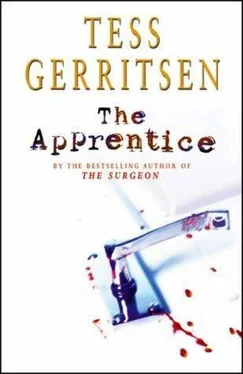She set down her fork, and its clatter against the table was startlingly loud.
From the bookshelf she picked up the packet of color-coded pushpins. She pressed a red one on the street where Gail Yeager had lived in Newton and pressed another red one in Stony Brook Reservation where Gail’s body was found. She added a second pin in Stony Brook-this one blue-to represent the remains of the unknown woman. Then she sat down and considered the geography of the unsub’s world.
During the Surgeon killings, she had learned to study a city map the way a predator studies his hunting grounds. She was, after all, a hunter as well, and to catch her prey she had to understand the universe in which he lived, the streets he walked, the neighborhoods he roamed. She knew that human predators most often hunted in areas that were familiar to them. Like everyone else, they had their comfort zones, their daily routines. So when she looked at the pins on the map, she knew that she was seeing more than just the location of crime scenes and body dumps; she was seeing his sphere of activity.
The town of Newton was upscale and expensive, a suburb of professionals. Stony Brook Reservation was three miles southeast, in a neighborhood not nearly as tony as Newton. Was the unsub a resident of one of these neighborhoods, stalking prey that crossed his path as he moved between home and work? He would have to be someone who fit in, someone who did not rouse suspicion as an outsider. If he lived in Newton, he’d have to be a white-collar man with white-collar tastes.
And white-collar victims.
The grid of Boston streets blurred before her tired eyes, yet she did not give up and go to bed; she sat in a daze beyond exhaustion, a hundred details swimming in her head. She thought of fresh sperm in a decomposing corpse. She thought of skeletal remains with no name. Navy-blue carpet fibers. A killer who sheds the hair of his past victims. A stun gun, a hunter’s knife, and folded nightclothes.
And Gabriel Dean. What was the FBI’s role in all this? She dropped her head in her hands, feeling as though if would explode with so much information. She had wanted to be lead detective, had even demanded it, and now the weight of this investigation was crushing her. She was too tired to think and too wound up to sleep. She wondered if this was what a breakdown felt like and ruthlessly suppressed the thought. Jane Rizzoli would never allow herself to be so spineless as to suffer a nervous breakdown. In the course of her career she had chased a perp across a rooftop, had kicked down doors, had confronted her own death in a dark cellar. She had killed a man.
But until this moment, she had never felt so close to crumbling.
The prison nurse is not gentle as she ties the tourniquet around my right arm, snapping the latex like a rubber band. It pinches my skin and tears at my hairs, but she does not care; to her, I am just another malingerer who has roused her from her cot and interrupted her normally uneventful shift in the prison clinic. She is middle-aged, or at least she looks it, with puffy eyes and overplucked brows, and her breath smells like sleep and cigarettes. But she is a woman, and I stare at her neck, loose and wattled, as she bends over my arm to locate a good vein. I think of what lies beneath her crepey white skin. The carotid artery, pulsing with bright blood, and beside it, the jugular vein, swollen with its darker river of venous blood. I am intimately familiar with the anatomy of a woman’s neck, and I study hers, unattractive as it is.
My antecubital vein has plumped up, and she grunts in satisfaction. She opens an alcohol swab and wipes it across my skin. It is a careless and slovenly gesture, not what one expects from a medical professional, done out of habit and nothing more.
“You’ll feel a poke,” she announces.
I register the prick of the needle without flinching. She has hit the vein cleanly, and blood streams into the red-topped Vacutainer tube. I have worked with the blood of countless others, but never my own, so I stare at it with interest, noting that it is rich and dark, the color of black cherries.
The tube is nearly full. She pulls it from the Vacutainer needle and pops a second tube onto the needle. This tube is a purple-top, for a complete blood count. When this one, too, is filled, she pulls the needle from my vein, snaps the tourniquet loose, and jams a wad of cotton against the puncture site.
“Hold it,” she commands.
Helplessly I rattle the handcuff on my left wrist, which is fastened to the frame of the clinic cot. “I can’t,” I say in a defeated voice.
“Oh, for God’s sake,” she sighs. No sympathy, just irritation. There are some who despise the weak, and she is one of them. Given absolute power, and a vulnerable subject, she could easily transform into the same sort of monsters who tortured jews in concentration camps. Cruelty is there beneath the surface, disguised by the white uniform and the name tag with R.N.
She glances at the guard. “Hold it,” she says.
He hesitates, then clamps his fingers against the cotton, pressing it to my skin. His reluctance to touch me is not because he’s afraid of any violence on my part; I have always been well behaved and polite, a model prisoner, and none of the guards fear me. No, it is my blood that makes him nervous. He sees red oozing into the cotton and imagines all sorts of microbial horrors swarming toward his fingers. He looks relieved when the nurse tears open a bandage and tapes the cotton wad in place. At once he goes to the sink and washes his hands with soap and water. I want to laugh at his terror of something as elemental as blood. Instead I lie motionless on the cot, my knees drawn up, my eyes closed, as I release an occasional whimper of distress.
The nurse leaves the room with the tubes of my blood, and the guard, his hands thoroughly washed, sits down in a chair to wait.
And wait.
What feels like hours goes by in that cold and sterile room. We hear nothing from the nurse; it’s as if she has abandoned us, forgotten us. The guard shifts in his chair, wondering what could be taking her so long.
I already know.
By now, the machine has completed its analysis of my blood, and she holds the results in her hand. The numbers alarm her. All concerns about a prisoner’s malingering have fled; she sees the evidence, there in the printout, that a dangerous infection rages in my body. That my complaint of abdominal pain is surely genuine. Although she has examined my belly, felt my muscles flinch, and heard me groan at her touch, she did not quite believe my symptoms. She has been a prison nurse too long, and experience has made her skeptical of inmates’ physical complaints. In her eyes we are all manipulators and con men, and our every symptom is just another pitch for drugs.
But a lab test is objective. The blood goes into the machine and a number comes out. She cannot ignore an alarming white blood cell count. And so she is surely on the telephone, consulting with the medical officer: “I have a prisoner here with severe abdominal pain. He does have bowel sounds, but his belly’s tender in the right lower quadrant. What really worries me is his white count …”
The door opens, and I hear the squeak of the nurse’s shoes on the linoleum. When she addresses me, there is none of that sneering tone she’d used earlier. Now she is civil, even respectful. She knows she is dealing with a seriously ill man and if anything should happen to me she will be held responsible. Suddenly I am not an object of contempt but a time bomb that could destroy her career. And she has already delayed too long.
Читать дальше












